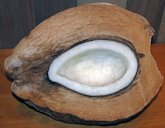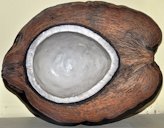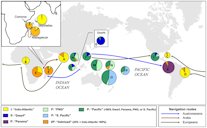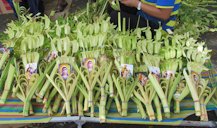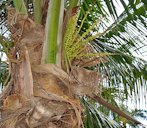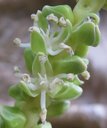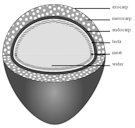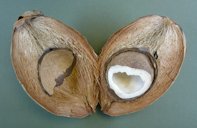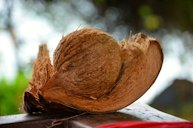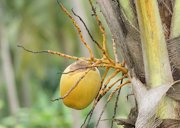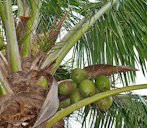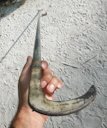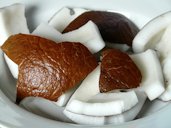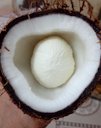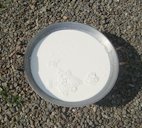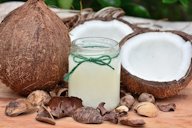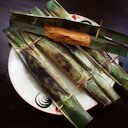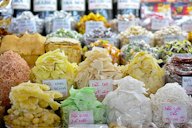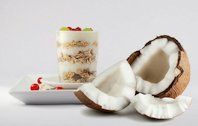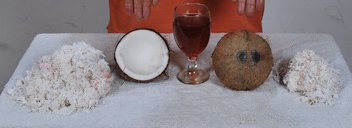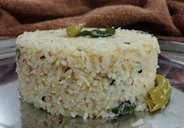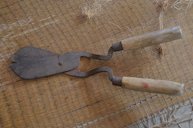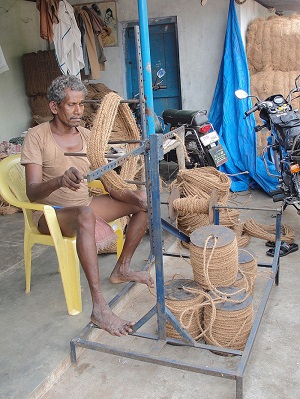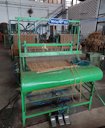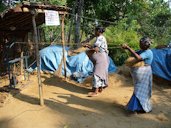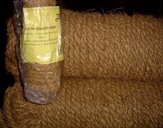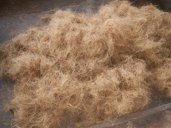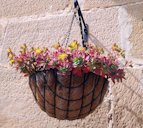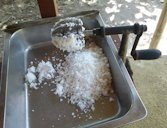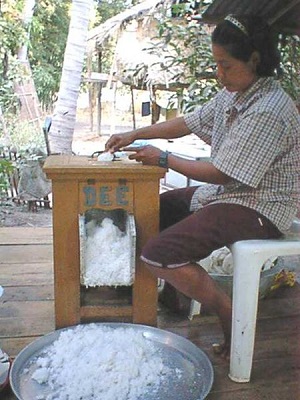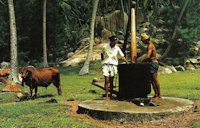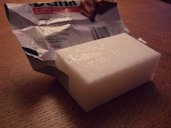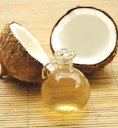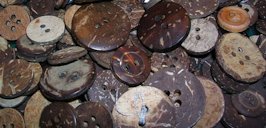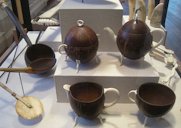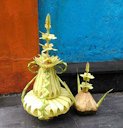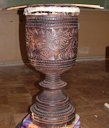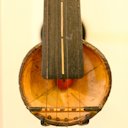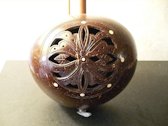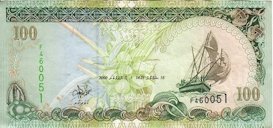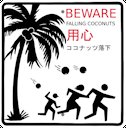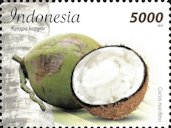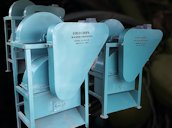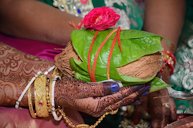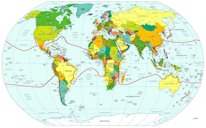| Coconut - Cocos nuficera | |||||||||||||||||||||||||||||||||||||||||||||||||||||||||||||||||||||||||||||||||||||||||||||||||||||||||||||||||||||||||||||||||
|---|---|---|---|---|---|---|---|---|---|---|---|---|---|---|---|---|---|---|---|---|---|---|---|---|---|---|---|---|---|---|---|---|---|---|---|---|---|---|---|---|---|---|---|---|---|---|---|---|---|---|---|---|---|---|---|---|---|---|---|---|---|---|---|---|---|---|---|---|---|---|---|---|---|---|---|---|---|---|---|---|---|---|---|---|---|---|---|---|---|---|---|---|---|---|---|---|---|---|---|---|---|---|---|---|---|---|---|---|---|---|---|---|---|---|---|---|---|---|---|---|---|---|---|---|---|---|---|---|---|
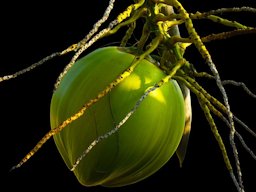 Fig. 1  Coconut, Cocos nuficera 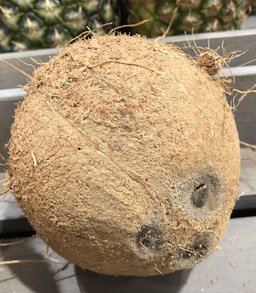 Fig. 2  A dehusked coconut shell showing the face-like markings at the base; the pea-sized embryo lies in the flesh under the ‘soft eye’, one of the three generative pores at the basal end of the nut 3 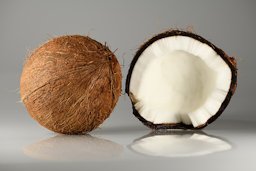 Fig. 3  Coconuts – single and cracked open. Grown in Dominican Republic 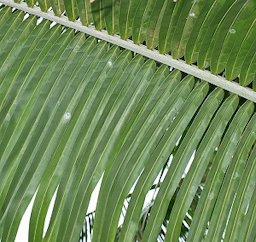 Fig. 4 Fig. 4C. nucifera leaflets  Fig. 5 Fig. 5
 C. nucifera closer view of leaflets 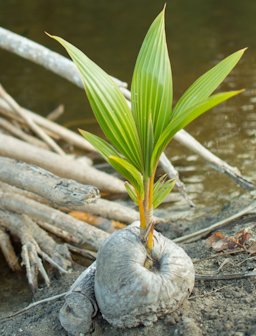 Fig. 10  Coconut (C. nucifera) sprout near the mouth of the river Ahoa (Tubuai, French Polynesia) 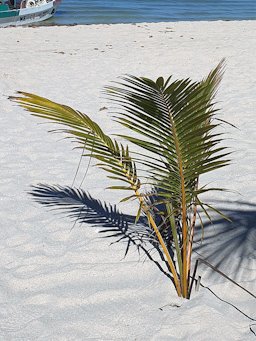 Fig. 11  Coconut palm (C. nucifera) sapling in Celestún, Yucatán, Mexico 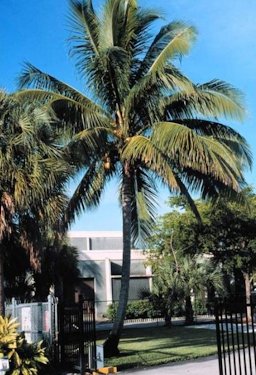 Fig. 12 A Maypan coconut palm, growing in Fort Lauderdale, Florida 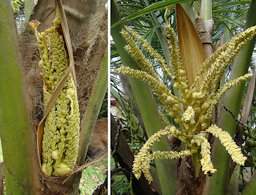 Fig. 13  C. nucifera, inflorescence unfurling 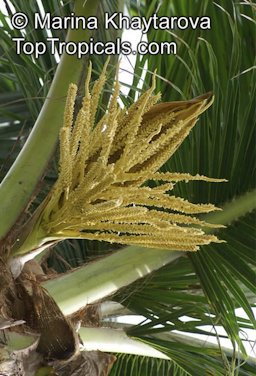 Fig. 14  Coconut inflorescense 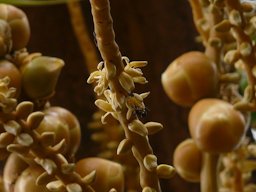 Fig. 15  C. nucifera flowers being pollinated by a bee, Thane, India. 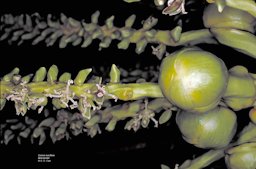 Fig. 16 Fig. 16
 Fruit forming 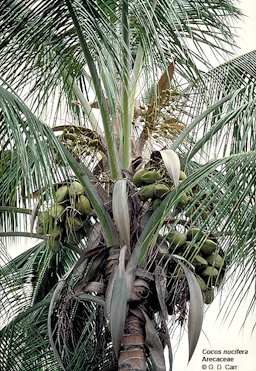 Fig. 20  Fruit of the C. nuficera 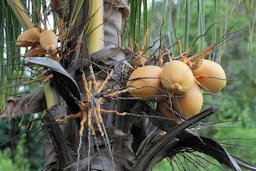 Fig. 21  Coconuts of the coconut palms tree C. nucifera on Sint Maarten 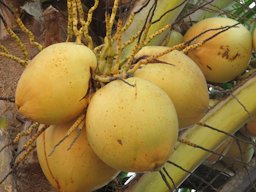 Fig. 22 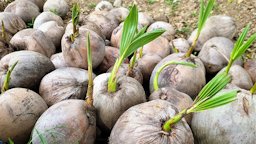 Fig. 33  Sprouted coconuts, Seoul, Korea 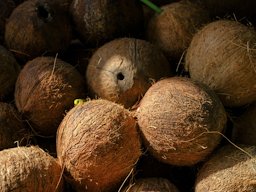 Fig. 36  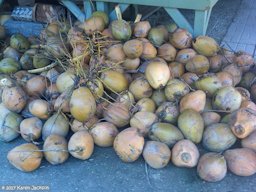 Fig. 37  Fresh coconuts for sale at the Pine Island Nursery fruit market, Florida 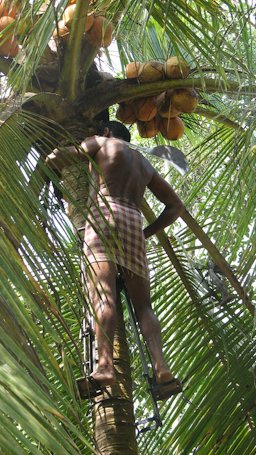 Fig. 38  A coconut harvester (Raghavan), near Chirakkadavu, Kanjirappally; coconut climbing tool also visible 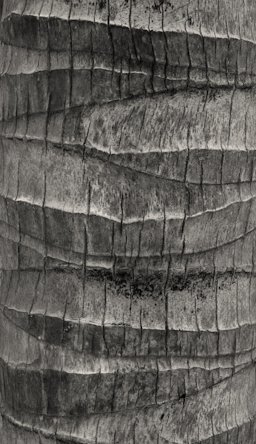 Fig. 39  Fig. 40  Exposed coconut root system 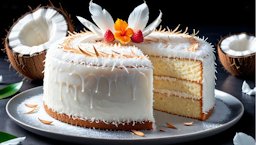 Fig. 51 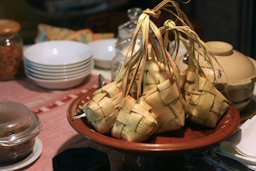 Fig. 52  Ketupat, traditional Indonesian rice cake, typically eaten for festive seasons 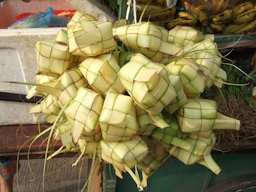 Fig. 53  In Indonesian markets, empty pouches of ketupat skin made from woven janur are often sold prior to Lebaran 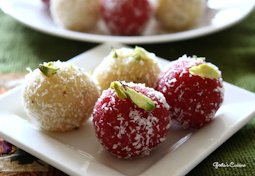 Fig. 54  Laddo made with coconut and natural color of beetroot (sweet from the Indian subcontinent) 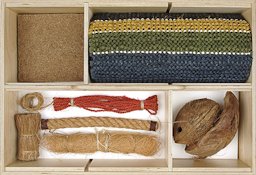 Fig. 55  Coir/coconut fiber - Tray and samples of the textile cabinet in the Textiel museum in Tilburg. Cabinet interior made by Simone de Waart. 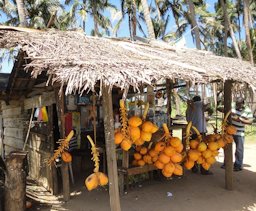 Fig. 83  King Coconut in Sri Lanka 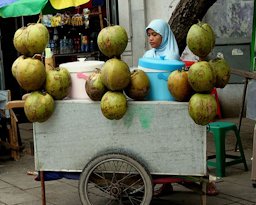 Fig. 84  A young lady sells fresh young iced coconuts in Old Town, Jakarta, Indonesia 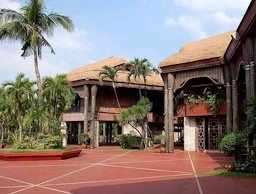 Fig. 85  Coconut Palace, Manila, Philippines, built entirely out of coconut and local materials 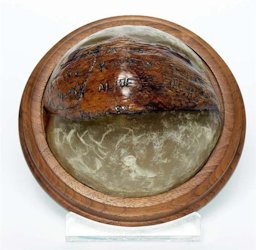 Fig. 86  Coconut shell paperweight (see opposite for information) 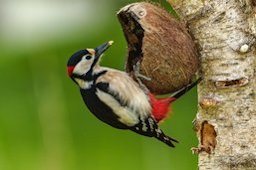 Fig. 94  Great spotted woodpecker, Dendrocopos major pinetorum, with coconut husk Back to Edible Palms Page |
Scientific name Cocos nuficera Linn. Pronunciation KOE-koase noo-SIFF-er-uh 8 Common Names English: coconut palm, copra; Spanish: coco de agua, cocotero, palma de coco, palmera cocotera, palmera de coco; French: coco, cocotier, cocoyer, noix de coco; Chinese: ye zi; Portuguese: coqueiro; Cuba: coco blanco, coco indio, coco morado; Germany: Kokosnusspalme; Italy: cocco; Caribbean: cocos, cocospalm, klapperboom 6 Synonyms C. nucifera var. synphyllica; Palma cocos Mill.; C. indica Royle; C. nana Griff.; Calappa nucifera (L.) Kuntze Family Arecaceae (palm family) Origin Believed to be native to the Malay Archipelago or the South Pacific USDA hardiness zones 10b-11 Uses Food; oil (soap, detergent, margarine); fiber (rope, mats, geotextiles); landscape value Longevity Tall coconuts are commonly grown for commercial purposes 40-90 years 7 Height 80-100 ft (24-31 m) Spread 15-25 ft (4.6-7.6 m) Crown Open crown, symmetrical Plant habit Large, single-trunked palm has a smooth, columnar trunk Growth rate Slow to rapid depending on the cultivar Trunk/bark/branches Branches don’t droop; not showy; typically one trunk with a light grayish-brown color 2 Pruning requirement Little required; palm is ‘self-pruning’ Leaves Up to 18 feet (5.5m) long; 4 feet (1.2 m) wide 2 Flowers White/cream/gray, not showy; male and female flowers are borne on the same inflorescence; coconut palms begin to flower at about 4-6 years of age Fruit Fibrous drupe, oval, round; 15 in. (38 cm) long x 12 in. (30 cm) wide; brown, green, yellow, showy 2 USDA Nutrient Content: raw, dry pdf Season All year; fruit set to maturity: 8-12 months Crop Yield Annual production of 50-200 fruits per tree, depending on cultivar and climate 2 Light requirement Full sun Soil tolerances Grows well in a wide range of soil types provided the soils are well drained pH preference 5.5-8.0 2 Drought tolerance Coconut palms are tolerant of dry soil conditions; however, for optimum fruit production and quality, regular irrigation is recommended during dry periods 2 Salt tolerance Tolerate brackish soils and salt spray 2 Cold tolerance Will be injured and may be killed by temperatures below 32 °F (0 °C) Wind Resitance Tolerant of windy sites; generally survive hurricane-force winds Plant spacing Commercially, they are planted 18-30 ft (5.5-9.1 m) apart; in the home landscape, they should not be crowded 2 Roots Very dense, fibrous root system that is mostly within 1.5 m (5 ft) of the soil surface 7 Invasive potential * Was determined that it is predicted to be invasive in South Florida. Luckily, it can still be planted if some conditions are satisfied (note below); it is not considered a problem species and may be recommended to plant with caution 11 Pest resistance Resistant to verticillium wilt; several diseases and some pests Known Hazard Falling fruit can cause blunt trauma injury and property damage 12 Reading Material Coconut Palm in Florida, University of Florida pdf Cocos nucifera L., Handbook of Energy Crops Cocos nucifera: Species Profiles for Pacific Islands, Agroforestry pdf Cocos nucifera, Agroforestree Database Cocos nucifera, PROSEA Foundation Note: Coconut palms may be planted in South Florida if these conditions are met: • Coconut palm must not be planted near canals (and other flowing waterways) or adjacent to natural areas. • Fallen fruit must be prevented from entering canals and other flowing waterways connected to open waters (including coastal). • Unwanted fruit must be placed in yard waste. Origin Comparatively little is known about the origin and early distribution of the coconut palm, probably because it was so widely spread throughout the tropical areas of the world so many years ago. However, the coconut palm is believed to be native to the Malay Archipelago or the South Pacific. 2 DNA analysis of more than 1,300 coconuts from around the world reveals that the coconut was brought under cultivation in two separate locations, one in the Pacific basin and the other in the Indian Ocean basin. What's more, coconut genetics also preserve a record of prehistoric trade routes and of the colonization of the Americas. 14
Fig. 6. The niu kafa form of the fruits of wild and Indo-Atlantic coconuts Fig. 7. The niu vai form of the fruits of domesticated Pacific coconuts Fig. 8. Distributions of Indo-Atlantic and Pacific coconut subpopulations Coconut fruits have two distinctive forms depending on domestication. Wild coconuts feature an elongated triangular fruit with a thicker husk and a smaller amount of endosperm. These allow the fruits to be more buoyant and make it easier for them to lodge into sandy shorelines, making their shape ideal for ocean dispersal. 14 Domesticated Pacific coconuts, on the other hand, are rounded in shape with a thinner husk and a larger amount of endosperm. Domesticated coconuts also have more amounts of coconut water. 14 The Pacific group is the only one to display clear genetic and phenotypic indications that they were domesticated; including dwarf habit, self-pollination, and the round "niu vai" fruit morphology with larger endosperm-to-husk ratios. 15 The coconuts that you find today in Florida are largely the Indian ocean type, which is why they tend to have the niu kafa form. 14 These two forms are referred to by the Samoan terms niu kafa for the elongated wild coconuts, and niu vai for the rounded domesticated Pacific coconuts. 14 Deep history of coconuts decoded: Origins of cultivation, ancient trade routes, and colonization of the Americas, ScienceDaily pdf Description This large, single-trunked palm has a smooth, columnar trunk with a light grayish-brown color; the trunk is topped with a terminal crown of leaves. Tall varieties may attain a height of 80-100 ft (24-31 m) while dwarf varieties are shorter in stature. The trunk is slender and often swollen at the base. The trunk is typically curved or leaning, but is erect in some cultivars. The coconut is the most extensively grown and used nut in the world and the most important palm. 2 The numerous uses of the coconut palm and its fruit are sometimes thought to have led to its wide cultivation in the tropics. The reverse is the case. It had a wide natural dissemination before Polynesians, and then Europeans, took it for one use in particular – as a source of pure, fresh, sweet drinking water – to regions to where it could not float. 3 The genus Cocos is monotypic, containing only the highly variable C. nucifera L. 3 Palm Morphology and Anatomy, University of Florida pdf (archived) Fruit Biology of Coconut (Cocos nucifera L.), MDPI Leaves The pinnate leaves are feather-shaped, up to 18 feet (5.5 m) long and 4 feet (1.2 m) wide. The leaf stalks are 3–5 feet (0.9–1.5 m) in length and spineless. 2 Precocity and yield are positively correlated with annual leaf formation, as an inflorescence appears in the axil of each leaf. Hence, dwarf varieties yield earlier and more than tall varieties. First flowering in tall varieties occurs at 5—7 years, in dwarf varieties after 2 years and in dwarf x tall hybrids about 3—4 years after germination. 16
Fig. 9. Tender leaves of coconut palms leaves (palaspas) during the observance of Palm Sunday in Baliuag, Bulacan, Philippines Flowers Male and female flowers are borne on the same inflorescence. The inflorescences emerge from canoe-shaped sheaths among the leaves and may be 2-3 ft (0.6-0.9 m) long and have 10-50 branchlets. 2 Male flowers are small, light yellow, and are found at the ends of the branchlets. Female flowers are larger than male flowers, light yellow in color, and are found towards the base of the branchlets. Coconut palms begin to flower at about 4-6 years of age. 2
Fig. 17. C. nucifera fibers and beginning of inflorescense Fig. 18. A part of coconut inflorescence showing male and female (proximal) flowers Fig. 19. Close-up of flowers of the coconut palm, Mozambique Pollination Flowering occurs continuously. Coconut palms are believed to be largely cross-pollinated, although most dwarf varieties are self-pollinating. 14 Pollinating insects are attracted by a small drop of nectar in each newly opened male flower and by a prolonged nectar supply for 2–3 days during the period of stigma receptivity of each female flower. 3 Fruit The fruits are produced in clusters near the growing tip. They vary in shape, but are generally near globose to oblong, up to a foot or more in length. The nut is encased in a thick, fibrous husk which is persistent and must be cut away to expose the nut. The shell is very hard and woody, near 0.25 in. (0.6 cm) thick. The edible, oily flesh or kernel adheres to the shell, and is about 0.25 in. (0.6 cm) thick, with a hollow center which contains a liquid during growth. The dried flesh or meat is the copra of commerce, produced in great quantities mainly for its oil. 1 Trees begin to yield fruit in 5-6 years on good soils, more likely 7-9 years, and reach full bearing in 12-13 years. Fruit set to maturity is 8-10 months, 12 months from setting of female flowers. 7 Coconuts are classified as a fibrous one-seeded drupe. A drupe is a fruit with a hard stony covering enclosing the seed (like a peach or olive) and comes from the word drupa meaning overripe olive. A coconut, and all drupes, have three layers: the exocarp (outer layer), the mesocarp (fleshy middle layer), and the endocarp (hard, woody layer that surrounds the seed). 9
Fig. 23. Layers of a mature coconut, some references identify the coconut meat (also called flesh) as solid endosperm, while the coconut water as liquid endosperm Fig. 24. Coconut Palm, longitudinal section fruit; Botanical Garden KIT, Karlsruhe, Germany Cultivars, University of Florida Over 100 varieties are known, about half of them 'tall' Harvesting Trees begin to yield fruit in 5-6 years on good soils, more likely 7-9 years, and reach full bearing in 12-13 years. Fruit set to maturity is 8-10 months; 12 months from setting of female flowers. 10 Harvesting of coconuts occurs throughout the year. The fruit should be harvested fully ripe for copra and dehydrated coconut. Drinking nuts should be picked earlier, at about seven months. The nuts may be harvested by skilled climbers or may be cut from the ground, using a knife attached to a long pole. Use of climbing spikes is not recommended since the wounds caused by the spikes are permanent and may provide entry sites for diseases, such as Thielaviopsis trunk rot. 2 Nuts must be harvested fully ripe for making copra or desiccated coconut. For coir they are picked about one month short of maturity, so that husks will be green. 7
Fig. 29. Sharp edged hook used for coconut plucking in the Maldives Fig. 30. Chief Tuimauga, a member of the Hale Koa Hotel luau, demonstrates the skill of climbing a tree to retrieve coconuts; the Hale Koa, an Armed Forces Recreation Center resort, hosts a luau on Mondays and Thursdays at 5 p.m. Fig. 31. Sri Lanka (Province du Sud): outil pour ouvrir les noix de coco (Tool used to open coconuts) Fig. 32. Ouverture des noix de coco (opening of coconuts) au Sri Lanka (entre Yapahuwa et Dambulla, au centre du pays) Coconut: Postharvest Quality-Maintenance Guidelines, University of Hawai'i at Mānoa pdf Propagation Coconut Palm propagation is entirely from seed – the coconuts, which are ready for planting if they produce an audible "sloshing" sound when shaken. The nuts are placed on their sides and buried with sand or mulch to about one-half the thickness of the nut. They may be planted in closely spaced rows in well drained seedbeds, or the nuts may be planted directly into large pots. Germination is best under high temperatures (90°F-100°F). Upon germination, the shoot and root emerge through the side or one end of the nut. Young palms, about 6 months old, can be transplanted directly into the field or can be grown in pots in the nursery for a few more years. 2 The fruit can float for long distances and still germinate to form new trees after being washed ashore. 2 Attempts to generate coconut palms by tissue culture have achieved only a handful of plants since the 1970s, despite the fact that coconut water (from the immature fruit) is a vital ingredient in tissue-culture media for many other plant species. 3
Coconut Palms from Seed, University of Hawai'i at Mānoa pdf Planting They can be successfully transplanted at any period in their growth, provided they are properly handled. Preplanting soil preparation depends upon soil type and depth of the water table. In low-lying areas, beds several feet high and wide should be constructed to prevent waterlogging of the root zone during wet periods. 2 Container-grown palms should be planted such that the bottom of the stem and top of the root system are about 1 inch below the surface of the soil. Field-grown palms should be planted at the same level at which they were previously grown. 2 Culture Coconut palms will be injured and may be killed by temperatures below 32°F (0°C) and may show chilling injury symptoms of leaflet necrosis at temperatures as high as 40°F (5°C). Prolonged exposure to non-freezing temperatures in the low to mid 30s°F can result in permanent trunk damage and even death of the palm. More severe freezes can also result in death of the bud. Research has shown that the severity of cold injury is greatly reduced for these palms when they have been properly fertilized. 2 Cold Damage on Palms, University of Florida pdf Fertilizing To prevent nutritional deficiencies from occurring or to correct mild deficiencies, regular maintenance fertilization with a "palm special" fertilizer is recommended. These fertilizers should have an analysis of approximately 8N-2P2O5-12K2O-4Mg. 2 The fertilizers should also have all of their N, K, and Mg in a controlled-release form to prevent rapid leaching of these nutrients through the soil. Additionally, the fertilizers should contain about 1-2 % Fe and Mn plus trace amounts of Zn, Cu, and B. 2 Fertilization of Field-Grown and Landscape Palms in Florida, University of Florida pdf Nutrition and Fertilization of Palms in Containers, University of Florida pdf Nutrient Deficiencies in Palms Irrigation At least 1 inch of water should be supplied weekly by rainfall or by irrigation, especially during the first year following transplanting. 2 Pruning Palm Trees Page Pests Page Disease Page Other Injuries Symptoms Food Uses The juicy, jelly-like endosperm (Fig. 34,42) in the young nuts is highly prized for eating out of the shell, for the water and for use in cooking. Immature (‘green’, ‘jelly’) coconuts are harvested 7–9 months after pollination. 3 Coconut milk, abundant in unripe nuts, is a refreshing and nutritious drink. It is also grown on a limited commercial basis in Florida for coco frio, a refreshing drink made from the water inside green coconuts. Mature nuts for copra, coir or desiccated coconut are left on the palm until 11 months or more from pollination when the fresh skin colour shows dry, brown patches to being fully brown and the coir is brown. 3 Mature coconuts (10–11 months) are also used after the hardening of the endosperm. The meat is firm and can be eaten fresh or may be used for making shredded coconut. The endosperm is shredded and squeezed to produce ‘coconut milk’ and ‘coconut cream’. 3 This tree is strong, resilient and can provide us with our most basic need for life - water! The most sterile water on earth is found in this nut. 5
Fig. 41. Fresh coconut meat Fig. 42. Sprouted coconut, eat with fingers/spoon) Fig. 43. Purest coconut milk ('kakang gata"), extracted from 15 fresh mature coconuts in Philippines Fig. 44. Fresh coconut water Fig. 45. Otak-otak from a shop in Katong, Singapore, puréed fish is mixed with a chilli paste, coconut milk and egg and then grilled, wrapped inside two sections of coconut palm leaf Fig. 46. Candied coconut types sold in Ho Chi Minh city Fig. 47. Breakfast Fig. 48. Fresh mature grated coconut meat, opened coconut, coconut healing oil, 2 "mata" (eyes) rarest coconut; fresh mature grated coconut meat, respectively (l-rt). Fig. 49. Coconut rice is traditionally made in south India along with crushed red chillies and curry leaves(karivepaku) in the tadka which give it a unique flavour Fig. 50. Chutney made with coriander leaves and coconut. South Florida Tropicals: Coconut, University of Florida pdf (archived) Fiber Uses The outer husk (mesocarp) of the fruit (‘nut’) is used as a fibre (coir), along with a non-fibrous product, coir dust (cocopeat). It now has widespread uses in horticulture as a replacement for peat moss. Green husks yield white coir (yellow fibres) for making ropes, carpets, mats and geo-textiles. Brown coir from husks of mature fruits is used in brushes (long bristle fibres), mattresses, upholstery and particle board (short fibres). 16 Fiber is resistant to sea water and is used for cables and rigging on ships. 10 Dried coconuts are dehusked manually by striking and twisting them on a steel point that is placed firmly in the ground. Dehusking machines have been developed but have not been a success. 16
Fig. 56. Fiber cutter used for cutting coconut fiber (coir) in Puri, Odisha by workers of non-profit Odiani working on coconut fiber craft. Odiani is located in Teisipur, Puri district, Odisha, India. Fig. 57. Extracting the fiber from the husk (Sri Lanka) Fig. 58. This photo depicting the process of rewinding of coconut coir with rope. Tamils widely using this rope for many purposes. Fig. 59. Anugraha loom, light weight loom for weaving coir Fig. 60. Public display by members of a cooperative making coir rope beside the backwaters near Kochi, Kerala, India; while the spindles are electrically operated, the women walk backwards about 30 metres each time, several hundred times a day, guiding the fibres through their hands from the baskets on their waists Fig. 61. Making doormats from coir Fig. 62. Ropes made of coconut fibres Fig. 63. Mise en place des boudins de renforcement en fibre de coco pour la restauration des berges; Parc Jean-Jacques-Rousseau, Ermenonville, France Fig. 64. Blocks made of coconut fibres and humus made for plant cultivation Fig. 65. Coconut husk fibers, Coconet Factory Elias Aldana (coconut geotextile) Las Piñas City Fig. 66. Coir planter Fig. 67. Bathing scrubbers made from coir fibers Copra Uses The most important economic product of the coconut is obtained by drying the endosperm of the nut into copra, which is pressed to produce coconut oil, primarily used in making soap and cosmetics. 2 Extraction of oil from copra is one of the oldest seed-crushing industries of the world. 10 In ripe nuts, the endosperm contains about 50% water and 35–40% oil. In preparing copra, the dried meat of the coconut, the nuts are cut in half, the milk drained off, and the nuts are exposed to sun. The partially dried meat contracts and can be readily removed from the shell. Further drying reduces the moisture to under 8 percent, necessary to prevent mold growth. Artificial heat is often used for this.
Fig. 68. Coconuts drying before being processed into copra Fig. 69. Râpe à noix de coco (grating tool) (Sri Lanka) Fig. 70. Woman grinding coconuts in Ban Dongphayom, Phitsanulok, Thailand Fig. 71. Traditional bullock-powered coconut oil mill, dried coconuts are crushed and oil is squeezed out Fig. 72. Coconut fat - saturated coconut oil - 100% fat Fig. 73. Coconut and oil Fig. 74. Coconut milk body lotion Fig. 75. Vegan soap Coconut Oil: A Heart Healthy Fat? University of Florida pdf Other Uses/Services Coconut water:The nut cavity is filled with water that tastes sweet when the coconut is young. Coconut water is now commercially preserved without altering its typical flavour. 16 Honey: Coconut honey is of exceptional quality. 7 Timber: C. nucifera timber has traditionally been used in tropical countries for the structural framework of houses. Coconut timber taken from the lower and middle parts of the trunk can be used for load-bearing structures in buildings, such as frames, floors and trusses. Coconut trunks can be used for poles, as they have great strength and flexibility. The wood can also be used for furniture and parquet flooring. 4 Outer wood is close-grained, hard, and heavy, and when well seasoned, has an attractive dark colored grain adaptable for carving, especially ornamentals under the name of 'porcupine wood'. 10 Alcohol: A clump of unopened flowers may be bound tightly together, bent over and its tip bruised. Soon it begins to 'weep' a steady dripping of sweet juice, containing about 15% sucrose, up to a gallon per day. It contains 16-30 mg ascorbic acid/100 g. The cloudy brown liquid is easily boiled down to syrup, called coconut molasses, then crystalized into a righ dark sugar, almost exactly like maple sugar. Sometimes it is mixed with grated coconut for candy. Left standing, it ferments quickly into a beer with alcohol content up to 8%, called 'toddy' in India and Sri Lanka; 'tuba' in Philippines and Mexico; and 'tuwak' in Indonesia. After a few weeks, it becomes a vinegar. 'Arrack' is the product after distilling fermented 'toddy' and is a common spirituous. 10 Ornamental: The sight of a coconut palm is a universal icon of tropical environments, appreciated by all. Living close to coconuts gives the added pleasure of the soft tapping noise produced by fronds gently blowing in the breeze. 7 Intercropping: Coconut palm is one of the most widely grown tree crops in the tropical countries. Its growth characteristics are ideal for small production and also for combining with other crops. The crown morphology and the relatively wide spacing facilitate the planting of a wide spectrum of field crops in coconut plantations. It has therefore been intercropped with cereals (cassava, sweet potatoes, yams) or fruits (bananas, passion fruit, pineapples and ground nuts) in many countries including Thailand, India, Sri Lanka, the Philippines etc. 4 Other: Coconut-shell flour, obtained from grinding clean, mature coconut shells to fine powder, is used as a filler in thermoplastic industry and an abrasive for cleaning machinery. Coconut-shell charcoal may be processed further into activated carbon that has many industrial applications, including general water purification, crystalline sugar preparation and gold purification. The edible mushrooms of the genus Auricularis grow well on coconut stems and are readily sold in China and elsewhere. 4 Medicinal Uses ** The roots are considered anti-pyretic and diuretic. Its decoctions are used against venereal diseases in Malay Peninsula while an infusion is used in Indonesia to treat dysentery. Milk of young coconut is diuretic, laxative, anti-diarrhoeic and counteracts the effects of poison. The oil is used to treat diseased skin and teeth and mixed with other medicines to make embrocations. The kernel of young fruit is mixed with other ingredients and rubbed on the stomach against diarrhoea. The kernel is prepared in Indo-China as a potion to treat ulcers of the skin and the nasal mucous membrane. 16 Coconut water is produced by a 5 month old nut, about 2 cups of crystal clear, cool sweet (invert sugars and sucrose) liquid, so pure and sterile that during World War II, it was used in emergencies instead of sterile glucose solution, and put directly into a patient's veins. 10 Products
Fig. 76. Sew-through coconut shell buttons Fig. 77. Coconut shell dipper and tea set - Old State House Museum, Boston, MA. USA. Fig. 78. Collections of the Treasury of Sint-Servaasbasiliek. Reliquiari con noce di cocco intagliata di fattura forse giapponese, montatura in argento del 1693. Fig. 79. Kembar mayang is a janur (young coconut leaves) arrangement that usually put in pair at javanese wedding ceremonies. It symbolises prosperity and togetherness. Fig. 80. The dabakan is a Philippine, single-headed, drum made of coconut lumber topped with a lizard or goat or even pig skin drumhead Fig. 81. A coconut guitar at the Musical Instrument Museum, Phoenix, Arizona Fig. 82. Detail of the carved back of the body of a Chinese yehu (2-stringed fiddle with coconut shell body); the white dots appear to be bone inlay, Kent, Ohio, United States, the yehu was probably made in Guangdong, China General Fig. 86. Original coconut on which the rescue message was inscribed by Kennedy to rescue the crew of the PT-109 and delivered by natives, Biuku Gasa and Eroni Kumana, of the Solomon Islands. From the source: While Kennedy was serving in WWII as commander of the PT109, his boat was hit by a Japanese destroyer and his crew was stranded in the Solomon Islands. Lieutenant John F. Kennedy carved this Coconut shell with a message and gave it to two natives to deliver to the PT base at Rendova so he and his crew would be rescued. He later had the coconut shell encased in wood and plastic and used it as a paperweight on his desk in the Oval Office. Message carved on coconut shell reads "NAURO ISL…COMMANDER…NATIVE KNOWS POS'IT…HE CAN PILOT…11 ALIVE…NEED SMALL BOAT…KENNEDY".
Fig. 87. Green coconut fruits on the coconut tree are featured on each Maldivian rufiyaa banknote. Republic of Maldives. Fig. 88. 'BEWARE FALLING COCONUTS' sign in Honolulu, Hawai'i Fig. 89. Commemorataive edition, stamp of Indonesia Fig. 90. A "Cocotaxi" in Havana (La Habana), Cuba Fig. 91. Coconut husk chips cutting machines
Fig. 93. The range of the natural habitat of the coconut palm tree delineated by the red line (based on information in Werth 1933) Further Reading The Coconut Odyssey, Australian Centre for International Agricultural Research pdf Coconuts: It’s A Matter of Degrees, Eat the Weeds More Images and Information Coconut Botanical Art List of Growers & Vendors |
||||||||||||||||||||||||||||||||||||||||||||||||||||||||||||||||||||||||||||||||||||||||||||||||||||||||||||||||||||||||||||||||
| Bibliography 1 Magness, J. R., et al. "Food and feed crops of the United States." Interregional Research Project IR-4, IR Bul. 1 (Bul. 828 New Jersey Agr. Expt. Sta.), 1971, New Crops Purdue University, hort.purdue.edu. Accessed 27 Apr. 2014. 2 Broschat, T. K., and Jonathan H. Crane. "The Coconut Palm In Florida." Horticultural Sciences Dept., UF/IFAS Extension, HS40, Original Pub. date Apr. 1984, Rev. June 2011, June 2014, Dec. 2017 and Dec. 2020, AskIFAS, edis.ifas.ufl.edu/mg043. Accessed 4 Nov. 2015, 12 Mar. 2019, 8 Mar. 2024. 3 The Encyclopedia of Fruit & Nuts. Edited by Jules Janick and Robert E. Paull, Cambridge, CABI, 2008. 4 Orwa, C., et al. "Cocos nucifera L." Agroforestree Database: a tree reference and selection guide, version 4.0., 2009, Agroforestry, apps.worldagroforestry.org/treedb2/speciesprofile.php?Spid=545. Accessed 13 Mar. 2024. 5 "Cocos nucifera (Arecaceae)." National Tropical Botanical Garden, ntbg.org. Accessed 2 Dec. 2015. 6 "Cocos nucifera (coconut)." Invasive Species Compendium, cabi.org. Accessed 2 Dec. 2015. 7 Martin, Franklin W. "The Coconut Palm." Multipurpose Palms You Can Grow, Chapter 3, Ed. Craig Elevitch, Agroforestry Net, agroforestry.org/multipurpose-palms-you-can-grow/coconut-palms. Accessed 21 Nov. 2015. 8 Deane, Green. "Coconuts: It’s A Matter of Degrees." Eat the Weeds and other things, too, www.eattheweeds.com/cocos-nucifera-a-matter-of-degrees-2/. Accessed 15 July 2017. 9 "Is Coconut a fruit, nut or Seed." Library of Congress, www.loc.gov/rr/scitech/mysteries/coconut.html. Accessed 13 Mar. 2019. 10 Duke, James, A. "Cocos nucifera L." Handbook of Energy Crops, Unpublished, 1983, hort.purdue.edu. Accessed 14 May 2014. 11 "Coconut Palm." Gardening Solutions, UF/IFAS Extension, AskIFAS, gardeningsolutions.ifas.ufl.edu/plants/trees-and-shrubs/palms-and-cycads/coconut-palm.html. Accessed 10 Mar. 2024. 12 Boning, Charles R. Florida's Best Fruiting Plants- Native and Exotic Trees, Shrubs, and Vines. Sarasota, Pineapple Press, 2006. 13 "Cracking the Coconut Code: Revealing Its Mystical Significance in Hindu Weddings." Braja Mandala, brajamandala.com/what-does-the-coconut-represent-in-a-hindu-wedding/. Accessed 11 Mar. 2024. 14 "Deep history of coconuts decoded: Origins of cultivation, ancient trade routes, and colonization of the Americas." ScienceDaily, Washington University in St. Louis, 24 June 2011, www.sciencedaily.com/releases/2011/06/110624142037.htm. Accessed 12 Mar. 2024. 15 Gunn, Bee F., et al. "Independent Origins of Cultivated Coconut (Cocos nucifera L.) in the Old World Tropics." PLOS ONE, June 22, 2011, doi:10.1371/journal. Accessed 13 Mar. 2024. 16 Ohler J. G., and S. S. Magat. "Cocos nucifera L." Plant Resources of South-East Asia No 14: Vegetable oils and fats, H. A. M. van der Vossen, and B. E. Umali (Editors), 2001, (CC BY-SA 3.0), PROSEA Foundation, Bogor, Indonesia, prosea.prota4u.org/view.aspx?id=829. Accessed 13 Mar. 2024. Photographs Fig. 1 Josch13. "Coconut." Pixabay, 4 Jan. 2014, (CC0), pixabay.com/photos//coconut-coconut-tree-plant-238933/. Accessed 11 Mar. 2024. Fig. 2 Fastily. "Coconut." Wikimedia Commons, 2010, (CC BY-SA 4.0), Image cropped, commons.wikimedia.org/wiki/File:Coconut_1_2018-03-29.jpg. Accessed 13 Mar. 2024. Fig. 3 Leidus, Ivar "Coconuts – single and cracked open. Grown in Dominican Republic." Wikimedia Commons, 28 Jan. 2022, (CC BY-SA 4.0), commons.wikimedia.org/wiki/file:Coconuts - single and cracked open.jpg. Accessed 9 Mar. 2024. Fig. 4,5,17,28 Anderson, Patti, J. "Cocos nucifera." Identifying Commonly Cultivated Palms, a Resource for Pests and Diseases of Cultivated Palms, 2011, idtools.org/id/palm/palmid. Accessed 16 Jan. 2014. Fig. 6 St. John, James. "The niu kafa form of the fruits of wild and Indo-Atlantic coconuts." Wikimedia Commons, via Flickr, 10 June 2011, (CC BY 2.0), commons.wikimedia.org/wiki/File:Cocos nucifera (coconut) 5 (38507429165).jpg. Accessed 13 Mar. 2024. Fig. 7 St. John, James. "The niu vai form of the fruits of domesticated Pacific coconuts." Wikimedia Commons, via Flickr, 17 Nov. 2012, (CC BY 2.0), commons.wikimedia.org/wiki/File:Cocos_nucifera_(coconut)_2_(39384972311).jpg. Accessed 13 Mar. 2024. Fig. 8 Gunn, Bee F., et al. "Distributions of Indo-Atlantic and Pacific coconut subpopulations." Wikimedia Commons, 22 June 2011, (CC BY-SA 4.0), commons.wikimedia.org/wiki/File:Geographical distributions of Indo-Atlantic and Pacific coconut subpopulations.png. Accessed 13 Mar. 2024. Fig. 9 RamaGaspar. "Tender leaves of coconut palms leaves (palaspas) during the observance of Palm Sunday in Baliuag, Bulacan, Philippines." Wikimedia Commons, 9 Apr. 2022, (CC BY-SA 4.0), Image cropped, commons.wikimedia.org/ wiki/File:DJN_32OZ_COCONUT_FRONT.jpg. Accessed 13 Mar. 2024. Fig. 10 Silvestro, Jérémie. "Coconut (Cocos nucifera) sprout near the mouth of the river Ahoa (Tubuai, French Polynesia)." Wikimedia Commons, 16 Dec. 2015, (CC BY-SA 4.0), Image cropped, commons.wikimedia.org/wiki/file:Pousse de cocotier.jpg. Accessed 9 Mar. 2024. Fig. 11 Dénes, Emőke. "Coconut palm (Cocos nucifera) sapling in Celestún, Yucatán, Mexico." Wikimedia Commons, 20 Nov. 2019, (CC BY-SA 4.0), commons.wikimedia.org/wiki/file:Arecales - Cocos nucifera - 12.jpg. Accessed 9 Mar. 2024. Fig. 12 "A Maypan coconut palm, growing in Ft. Lauderdale, Fla." Horticultural Sciences Dept., UF/IFAS Extension, 2008, AskIFAS, edis.ifas.ufl.edu/mg043 Accessed 28 Apr. 2014. Fig. 13 Culbert, Dick. "Cocos nucifera Inflorescence unfurling." Wikimedia Commons, 19 Oct. 2014, (CC BY 2.0), commons.wikimedia.org/wiki/file:Cocos nucifera (11124377083).jpg. Accessed 11 Mar. 2024. Fig. 14 Khaytarova, Marina. "Cocos nucifera." Top Tropicals, toptropicals.com. Accessed 16 Jan. 2014. Fig. 15 Valke, Dinesh. "Cocos nucifera flowers being pollinated by a bee. Thane, India." Wikimedia Commons, 2008, (CC BY-SA 2.0), commons.wikimedia.org/wiki/Category:Cocos_nucifera. Accessed 2 May 2017. Fig.16,20 Carr, Gerald D. "Cocos nucifera." University of Hawai'i, Botany Dept., Mānoa Campus Plants, botany.hawaii.edu. Accessed 12 Oct. 2013. Fig. 18 Kembangraps. "A part of coconut inflorescence. Showing male and female (proximal) flowers." Wikimedia Commons, 25 Aug. 2016, (CC0), commons.wikimedia.org/wiki/File:Coconut_flower1_Pj_DSC_1951.jpg. Accessed 14 Mar. 2024. Fig. 19 Rulkens, Ton. "Close-up of flowers of the coconut palm, Mozambique." Wikimedia Commons, via Flickr, 25 Feb. 2011, (CC BY-SA 4.0), commons.wikimedia.org/wiki/File:Coconut_flowers_(5476099379).jpg. Accessed 13 Mar. 2024. Fig. 21 Harrison, Paul. "Coconuts of the coconut palms tree Cocos nucifera on Sint Maarten." Wikimedia Commons, 1 Jan. 2011, (CC BY-SA 4.0), commons.wikimedia.org/wiki/file:Coconut_palm_Cocos_nucifera_St_Maarten_2011_6780.jpg. Accessed 9 Mar. 2024. Fig. 22 Vijayanarasimha. "Coconut." Pixabay, 10 Jan. 2014, (CC0), pixabay.com/photos/coconuts-nuts-cocos-nucifera-241990/. Accessed 11 Mar. 2024. Fig. 24 Kerina yin. "Matured coconut, sectioned to display layers. Layers are labeled." Wikimedia Commons, 2006, (CC BY-SA 3.0), commons.wikimedia.org. Accessed 1 May 2017. Fig. 25 Zell, H. "Coconut Palm, longitudinal section fruit; Botanical Garden KIT, Karlsruhe, Germany." Wikimedia Commons, 2010, (CC BY-SA 3.0), commons.wikimedia.org. Accessed 1 May 2017. Fig. 18 "Cocos nucifera." Top Tropicals, toptropicals.com. Accessed 16 Jan. 2014. Fig. 25 Grobe, Hannes. "Opened coconut." Wikimedia Commons, 2008, (CC BY 3.0), commons.wikimedia.org/wiki/File:Cocco-nut_hg.jpg. Accessed 13 Mar. 2024. Fig. 26 atlounge. "Coconut." Pixabay, 3 Dec. 2015, (CC0), pixabay.com/photos/coconut-paradise-thailand-1075425/. Accessed 11 Mar. 2024. Fig. 27 Vengolis. "Coconut." Wikimedia Commons, 22 Aug. 2015, (CC BY-SA 4.0), Image cropped, commons.wikimedia.org/wiki/file:Coconut tree 06264.JPG. Accessed 9 Mar. 2024. Fig. 29 Tutrin. "Sharp edged hook used for coconut plucking in the Maldives." Wikimedia Commons, 2014,(CC BY-SA 4.0), commons.wikimedia.org. Accessed 1 May 2017. Fig. 30 "Chief Tuimauga, a member of the Hale Koa Hotel luau, demonstrates the skill of climbing a tree to retrieve coconuts. The Hale Koa, an Armed Forces Recreation Center resort, hosts a luau on Mondays and Thursdays at 5 p.m." U.S. military or Department of Defense, 2009, Wikimedia Commons, Public domain, commons.wikimedia.org. Accessed 2 May 2017. Fig. 31 Ji-Elle. "Sri Lanka (Province du Sud): outil pour ouvrir les noix de coco." Wikimedia Commons, 2013, (CC BY-SA 3.0), commons.wikimedia.org. Accessed 2 May 2017. Fig. 32 Ji-Elle. "Ouverture des noix de coco au Sri Lanka (entre Yapahuwa et Dambulla, au centre du pays." Wikimedia Commons, 2013, (CC BY-SA 3.0), commons.wikimedia.org. Accessed 2 May 2017. Fig. 33 spiagol56. "Sprouted coconuts, Seoul, Korea." Pixabay, 22 Nov. 2019, (CC0), pixabay.com/photos/coconut-fruit-tropical-fruit-bud-4644549/. Accessed 11 Mar. 2024. Fig. 34 Filo gèn'. "Cocos nucifera drup." Wikimedia Commons, 26 Dec. 2018, (CC BY-SA 4.0), commons.wikimedia.org/wiki/file:Cocos nucifera - Drup (Arecaceae) 02.jpg. Accessed 9 Mar. 2024. Fig. 35 shanmugam, Sai K. "Coconut seedling." Wikimedia Commons, 20 Feb. 2012, (CC BY-SA 3.0), commons.wikimedia.org/wiki/file:Coconut seedling DSCN0417.JPG. Accessed 9 Mar. 2024. Fig. 36 Engin_Akyurt. "Coconut." Pixabay, 15 Nov. 2022, (CC0), pixabay.com/photos/tropical-coconut-summer-market-7594916/. Accessed 11 Mar. 2024. Fig. 37 Jackson, Karen. "Fresh coconuts for sale at the PineIsland nursery fruit market, Florida." 2017, www.growables.org. Fig. 38 Praveenp. "A coconut harvester (Raghavan), near Chirakkadavu, Kanjirappally. Coconut climbing tool also visible." Wikimedia, 2009, Transferred from ml.wikipedia to Commons by Sreejith K (talk), Public domain, wikimedia.org. Accessed 4 Nov. 2015. Fig. 39 Martin, Steve L. "Coconut palm (Cocos nucifera)." Wikimedia Commons, via Flickr, 6 Apr. 2007, (CC BY 2.0), commons.wikimedia.org/wiki/file:Cocos nucifera trunk (SLiM).jpg. Accessed 9 Mar. 2024. Exposed coconut root system Fig. 40 Assy. "Coconut." Pixabay, 4 Sept. 2016, (CC0), pixabay.com/photos//root-coconut-palms-exotic-tropical-1644944/. Accessed 11 Mar. 2024. Fig. 41 Braxmeier, Hans. "്Coconut meat." Wikimedia Commons, via Pixabay, 16 Oct. 2012, (CC0), commons.wikimedia.org/wiki/File:Coconut-60397_-_Hans_Braxmeier.jpg. Accessed 13 Mar. 2024. Fig. 42 Vishvaradhya. "്Can one imagine how little a baby coconut plant must be which grows all the way tall reaching skies if not see this pic which shows baby coconut in the tummy." Wikimedia Commons, 12 Feb. 2017, (CC BY-SA 4.0), Image cropped commons.wikimedia.org/wiki/file:Coconut_pong_open.JPG. Accessed 13 Mar. 2024. Fig. 43 FVelasquez, Ramon. "Purest coconut milk ('kakang gata"), extracted from 15 fresh mature coconuts in Philippines." Wikimedia, 2012, (CC BY-SA 3.0 US), Image cropped, wikimedia.org. Accessed 30 Apr. 2017. Fig. 44 moho01. "Fresh-water-coconut." Pixabay, 5 Jan. 2018, (CC0), pixabay.com/photos/food-coconut-fruit-healthy-3062139/. Accessed 11 Mar. 2024. Fig. 45 Takeaway. "Otak-otak from a shop in Katong, Singapore. Puréed fish is mixed with a chilli paste, coconut milk and egg and then grilled, wrapped inside two sections of coconut palm leaf." Wikimedia Commons, 2012, (CC BY 2.0), commons.wikimedia.org. Accessed 1 May 2017. Fig. 46 amrufm. "Candied coconut types sold in Ho Chi Minh City." Wikimedia Commons, 2011, (CC BY 2.0), commons.wikimedia.org. Accessed 30 Apr. 2017. Fig. 47 Mohamed_hassan. "Coconut breakfast." Pixabay, 9 July 2018, (CC0), pixabay.com/photos/coconut-breakfast-food-cornflakes-3526369/. Accessed 11 Mar. 2024. Fig. 48 Velasquez Ramon F. "Fresh mature grated coconut meat, opened coconut, coconut healing oil, 2 "mata" (eyes) rarest coconut and Fresh mature grated coconut meat, respectively (l-rt)." Wikimedia Commons, 2010, (CC BY-SA 3.0), commons.wikimedia.org. Accessed 6 Nov. 2015. Fig. 49 Jsn.2k11. "Coconut rice is traditionally made in south India along with crushed red chillies and curry leaves(karivepaku) in the tadka which give it a unique flavour." Wikimedia Commons, 9 June 2015, (CC BY-SA 4.0), Image cropped, commons.wikimedia.org/wiki/file:Coconut_rice.jpg. Accessed 11 Mar. 2024. Fig. 50 Nithyasrm. "Chutney made with coriander leaves and coconut." Wikimedia Commons, 19 Oct. 2014, (CC BY-SA 4.0), commons.wikimedia.org/wiki/file:Coriander coconut chutney.JPG. Accessed 11 Mar. 2024. Fig. 51 AnarkaliArt. "Coconut cake." Pixabay, 2 Oct. 2023, (CC0), pixabay.com/illustrations/ai-generated-cake-coconut-cream-8288200/. Accessed 11 Mar. 2024. Fig. 52 Chaerani, Meutia. "Ketupat, traditional indonesian rice cake. Typically eaten for festive seasons." Wikimedia Commons, 2005, (CC BY 2.5), commons.wikimedia.org. Accessed 2 May 2017. Fig. 53 Midori, Sakurai. "In Indonesian markets, empty pouch of ketupat skin made from woven janur are often sold prior to Lebaran." Wikimedia Commons, 23 Oct. 2006, Public domain, commons.wikimedia.org/wiki/file:Kulit ketupat.JPG. Accessed 9 Mar. 2024. Fig. 54 Geeta ram2003. "Laddo made with coconut and natural color of beetroot." Wikimedia Commons, 15 Sept. 2014, (CC BY-SA 4.0), commons.wikimedia.org/wiki/file:Coconut Laddo.jpg. Accessed 9 Mar. 2024. Fig. 55 Vogels, Joep. "Coir/Coconut fiber - Tray and samples of the textile cabinet in the Textielmuseum in Tilburg. Cabinet interior made by Simone de Waart, Material Sense." Wikimedia Commons, 2011, (CC BY-SA 4.0), commons.wikimedia.org. Accessed 2 May 2017. Fig. 56 Panigrahi, Subhashish. "Fiber cutter used for cutting coconut fiber (coir) in Puri, Odisha by workers of non-profit Odiani working on coconut fiber craft. Odiani is located in Teisipur, Puri district, Odisha, India." Wikimedia Commons, 2014, (CC BY-SA 4.0), commons.wikimedia.org. Accessed 2 May 2017. Fig. 57 Krankman. "Extracting the fiber from the husk (Sri Lanka)." Wikimedia, 2006, (CC BY-SA 2.5), wikimedia.org. Accessed 30 Apr. 2017. Fig. 58 Maari, Thamizhpparithi. "This photo depicting the process of rewinding of coconut coir pith rope. Tamils widely using this rope for many purposes." Wikimedia Commons, 2011, (CC BY-SA 3.0), commons.wikimedia.org. Accessed 2 May 2017. Fig. 59 Vis M. "Anugraha loom." Wikimedia Commons, 16 Sept. 2023, (CC BY-SA 4.0), Image cropped, commons.wikimedia.org/wiki/File:Berge4.JPG. Accessed 12 Mar. 2024. Fig. 60 Bricaniwi. "Public display by members of a cooperative making coir rope beside the backwaters near Kochi, Kerala, India. While the spindles are electrically operated, the women walk backwards about 30 metres each time, several hundred times a day, guiding the fibres through their hands from the baskets on their waists." Wikimedia Commons, 2010, (GFDL), commons.wikimedia.org. Accessed 2 May 2017. Fig. 61 Hagens, Wouter. "Making doormats from coir. India." Wikimedia Commons, 2004, (CC BY-SA 3.0), commons.wikimedia.org. Accessed 2 May 2017. Fig. 62 StromBer. "Ropes made of coconut fibres." Wikimedia Commons, 2008, Public domain, commons.wikimedia.org. Accessed 2 May 2017. Fig. 63 Patrick.charpiat. "Mise en place des boudins de renforcement en fibre de coco pour la restauration des berges. Parc Jean-Jacques-Rousseau, Ermenonville, France." Wikimedia Commons, Mar. 2011, (CC BY 3.0), GFDL, commons.wikimedia.org/. Accessed 13 Mar. 2024. Fig. 64 D-Kuru. "Blocks made of coconut fibres and humus made for plant cultivation." Wikimedia Commons, 2008, (CC BY-SA 3.0), commons.wikimedia.org. Accessed 3 May 2017. Fig. 65 Judgefloro. "Coconut husk fibers, Coconet Factory Elias Aldana (coconut geotextile) Las Piñas City." Wikimedia Commons, 27 Sept. 2017, (CC0), commons.wikimedia.org/wiki/File:6617Las_Piñas_City_Barangays_Landmarks_28.jpg. Accessed 13 Mar. 2024. Fig. 66 Engin_Akyurt. "Coconut." Pixabay, 3 Apr. 2016, (CC0), Image cropped, pixabay.com/photos/plant-pot-flowerpot-plant-ornament-1301474/. Accessed 11 Mar. 2024. Fig. 67 Vis M. "Bathing scrubbers made from coir fibers." Wikimedia Commons, 26 May 2023, (CC BY-SA 4.0), Image cropped, commons.wikimedia.org/wiki/File:Bathing_scrubbers_made_from_coir_fibers.jpg. Accessed 13 Mar. 2024. Fig. 68 Dan-johnson. "Coconut." Pixabay, 6 July 2020, (CC0), pixabay.com/photos/coconut-organic-coconut-5375501/. Accessed 11 Mar. 2024. Fig. 69 Ji-Elle. "Râpe à noix de coco (Sri Lanka)." Wikimedia Commons, 26 Jan. 2013, (CC BY-SA 3.0), Image cropped, commons.wikimedia.org/wiki/wiki/File:Sri_Lanka-Coconut_scraper.jpg. Accessed 3 May 2017. Fig. 70 Kborland. "Woman grinding coconuts in Ban Dongphayom, Phitsanulok, Thailand." Wikimedia Commons, 2001, (CC BY-SA 3.0), commapnear40ons.wikimedia.org. Accessed 3 May 2017. Fig. 71 Sassi, Dino. "Traditional bullock-powered coconut oil mill. Dried coconuts are crushed and oil is squeezed out." c. 1970, Scanned from the photo album: Maxime Fayon, Seychelles, Photo Eden, Victoria (Seychelles) 1977, Public domain according to the law of the Seychelles, commons.wikimedia.org. Accessed 30 Apr. 2017. Fig. 72 User: Friman. "Coconut-fat - saturated coconut oil - 100% fat." Wikimedia Commons, 2007, Public domain, commons.wikimedia.org. Accessed 1 May 2017. Fig. 73 Dầu dừa. "Coconut and oil." Wikimedia Commons, 2010, (CC BY-SA 2.0), commons.wikimedia.org. Accessed 3 May 2017. Fig. 74 BD_Vaghasiya. "Coconut milk body lotion." Pixabay, 1 Feb. 2017, (CC0), pixabay.com/illustrations/body-lotion-coconut-treatment-2030704/. Accessed 11 Mar. 2024. Fig. 75 Sambuzak32. "Vegan Soap." Wikimedia Commons, 5 May 2020, (CC BY-SA 4.0), Image cropped, commons.wikimedia.org/wiki/File:DJN_32OZ_COCONUT_FRONT.jpg. Accessed 13 Mar. 2024. Fig. 76 Tyranny Sue. "Sew-through coconut shell buttons." Wikimedia Commons, 2010, (CC BY-SA 3.0), commons.wikimedia.org. Accessed 3 May 2017. Fig. 77 "Coconut shell dipper and tea set - Old State House Museum, Boston, MA. USA." Wikimedia Commons, Public domain, commons.wikimedia.org. Accessed 3 May 2017. Fig. 78 Sailko. "Collections of the Treasury of Sint-Servaasbasiliek. Reliquiari con noce di cocco intagliata di fattura forse giapponese, montatura in argento del 1693." Wikimedia Commons, 2016, (CC BY 3.0), commons.wikimedia.org. Accessed 3 May 2017. Fig. 79 Kembangraps. "Kembar mayang is a janur (young coconut leaves) arrangement that usually put in pair at javanese wedding ceremonies. It symbolises prosperity and togetherness." Wikimedia Commons, 2016, (CC0), commons.wikimedia.org. Accessed 3 May 2017. Fig. 80 Mercurio, Philip Dominguez. "The dabakan is a Philippine, single-headed, drum made of coconut lumber topped with a lizard or goat or even pig skin drumhead." Wikimedia Commons, 26 July 2006, (CC BY-SA 2.5), Image cropped, commons.wikimedia.org/wiki/File:Dabakan_2.jpg. Accessed 13 Mar. 2024. Fig. 81 Dooley, Kevin. A coconut guitar at the Musical Instrument Museum, Phoenix, Arizona." Wikimedia Commons, 31 July 2010, (CC BY 2.0), commons.wikimedia.org/wiki/File:Coconut_guitar_(5532251995).jpg. Accessed 13 Mar. 2024. Fig. 82 Badagnani. "Detail of the carved back of the body of a Chinese yehu (2-stringed fiddle with coconut shell body). The white dots appear to be bone inlay. Kent, Ohio, United States. The yehu was probably made in Guangdong, China." Wikimedia Commons, 2008, (CC BY-SA 3.0), commons.wikimedia.org. Accessed 3 May 2017. Fig. 83 Singhalawap. "King Coconut in Sri Lanka." Wikimedia, 2010, (CC BY-SA 3.0), wikimedia.org. Accessed 30 Apr. 2017. Fig. 84 Prayitno. "A young lady sells fresh young iced coconuts in Old Town, Jakarta, Indonesia." Wikimedia Commons, 2013, (CC BY 2.0), commons.wikimedia.org. Accessed 1 May 2017. Fig. 85 Shaffner, Paul. "Coconut Palace, Manila, Philippines, built entirely out of coconut and local materials." Wikimedia, 2007, (CC BY 2.0), wikimedia.org. Accessed 30 Apr. 2017. Fig. 86 "Coconut Shell Paperweight." jfklibrary.org, 2008, Wikimedia Commons, Public domain, commons.wikimedia.org. Accessed 3 May 2017. Fig. 87 User: Jolie. "Green coconut fruits on the coconut tree are featured on each Maldivian rufiyaa banknote. Republic of Maldives." Wikimedia, 2009, (CC BY-SA 4.0), wikimedia.org. Accessed 30 Apr. 2017. Fig. 88 Wmpearl. "'BEWARE FALLING COCONUTS' sign in Honolulu, Hawai'i." Wikimedia Commons, 2011, (CC0), commons.wikimedia.org/wiki/File:BEWARE_FALLING_COCONUTS_sign_in_Honolulu_Hawaii-Vector.svg. Accessed 12 Mar. 2024. Fig. 89 "Commemorataive edition, stamp of Indonesia." Wikimedia Commons, 16 Oct. 2027, Public Domain, commons.wikimedia.org/wiki/Category:Coconuts_on_stamps#/media/File:Stamp_of_Indonesia_-_2017_-_Colnect_947709_-_ Kelapa_kopyor.jpeg. Accessed 12 Mar. 2024. Fig. 90 "A "Cocotaxi" in Havana (La Habana), Cuba." Wikimedia, 2011, (CC BY-SA 3.0), wikimedia.org. Accessed 30 Apr. 2017. Fig. 91 Coconutsl. "Coconut husk chips cutting machines." Wikimedia Commons, 27 Oct. 2019, (CC BY-SA 4.0), Image cropped, commons.wikimedia.org/wiki/file:Coconut husk chips cutting machines.jpg. Accessed 9 Mar. 2024. Fig. 92 BD_Vaghasiya. "Coconut symbolism." Pixabay, 30 May 2018, (CC0), pixabay.com/photos/wedding-marriage-indian-hindu-3443338/. Accessed 11 Mar. 2024. Fig. 93 Jonsson, Niklas. "The range of the natural habitat of the coconut palm tree delineated by the red line (based on information in Werth 1933)." Wikimedia, 2009, (CC BY-SA 3.0 US), wikimedia.org. Accessed 30 Apr. 2017. Fig. 94 apnear40. "Great spotted woodpecker, Dendrocopos major pinetorum, with coconut husk." Pixabay, 2017, (CC0), pixabay.com/photos/great-spotted-woodpecker-branch-8217675/. Accessed 11 Mar. 2024. * UF/IFAS Assessment of Non-native Plants in Florida's Natural Areas ** Information provided is not intended to be used as a guide for treatment of medical conditions. Published 2 May 2015 LR. Last update 13 Mar. 2024 LR |
|||||||||||||||||||||||||||||||||||||||||||||||||||||||||||||||||||||||||||||||||||||||||||||||||||||||||||||||||||||||||||||||||
